
Motor oils for VW Polo engines - do-it-yourself selection and replacement
Content
One of the most popular sedans among Russian motorists is the German Volkswagen Polo. The model has been produced and sold in Russia since 2011, having won an army of fans of the products of the VAG automobile concern. The vehicle, at a moderate cost, is an excellent choice for most Russians. This is a family car. The salon is quite spacious, all family members can travel in it comfortably. The spacious trunk of the sedan allows you to place the necessary things for travel and recreation.
What motor lubricants VAG recommends
While cars are serviced under warranty, most of their owners do not ask themselves what kind of lubricant an official dealer puts into their engine. But when the warranty period ends, you have to make a choice yourself. For many, this is a painful procedure, since the choice of engine oils on the market is huge. How can you select the right products from this variety in order to narrow your search?
To this end, the specialists of the VAG concern have developed tolerance specifications. Each of the tolerances defines the main characteristics that a motor fluid must meet in order to properly service engines of the Volkswagen, Skoda, Audi and Seat brands. In order to obtain a certificate of conformity to a particular tolerance, the oil fluid is subjected to numerous analyzes, tests and tests on Volkswagen gasoline and diesel engines. The process is long and expensive, but for certified motor oil, the market is expanding significantly.

According to the service documentation, oils with approvals 501.01, 502.00, 503.00, 504.00 can be used for gasoline engines of Volkswagen Polo cars. Lubricants with VW 505.00 and 507.00 approval are suitable for diesel units. Volkswagen Polo cars manufactured at the Kaluga plant until 2016 were equipped with EA 4 petrol 16-cylinder 111-valve aspirated engines developing 85 or 105 horsepower. Now sedans are equipped with upgraded EA 211 power plants with slightly more power - 90 and 110 horses.
For these engines, the best choice is a synthetic oil that has Volkswagen approvals, numbered 502.00 or 504.00. For modern engine warranty service, dealers use Castrol EDGE Professional LongLife 3 5W-30 and VW LongLife 5W-30. Castrol EDGE is also used as a first fill oil on the assembly line.
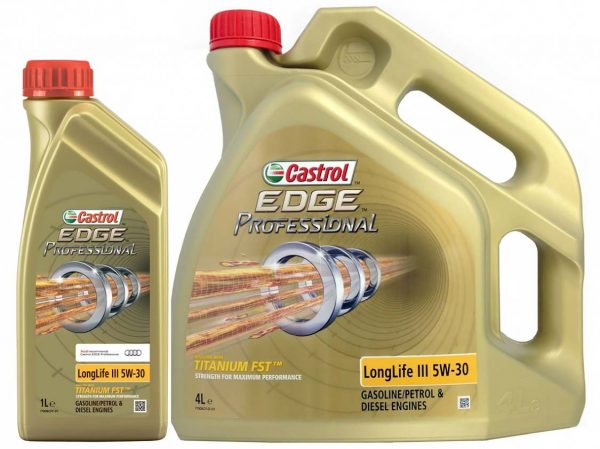
In addition to the above lubricants, there is a large selection of equally high quality products. Among them: Mobil 1 ESP Formula 5W-30, Shell Helix Ultra HX 8 5W-30 and 5W-40, LIQUI MOLY Synthoil High Tech 5W-40, Motul 8100 X-cess 5W-40 A3 / B4. All of these products have received many positive reviews from VW car owners. This is quite natural - the names of the brands speak for themselves. You can also use products from other renowned manufacturers with the same approvals.
What are the preferable engine oil tolerances
Which of the permitted Volkswagen tolerances will be the best for Russian operating conditions? 502.00 includes lubricants for direct injection engines with increased power. Tolerances 505.00 and 505.01 are intended for lubricants for diesel engines. 504/507.00 are approvals for the latest lubricants for gasoline (504.00) and diesel (507.00) engines. Such oils are characterized by an extended service interval and low sulfur and phosphorus content (LowSAPS). They apply to engines with particulate filters and exhaust gas catalysts.
Of course, it is good to change the lubricant after 25–30 thousand kilometers, and not after 10–15 thousand, as official dealers do. But such intervals are not for Russian operating conditions and our gasoline. Regardless of the brand of oil and tolerances, you need to change it much more often - every 7-8 thousand kilometers of travel. Then the engine will serve for a long time.
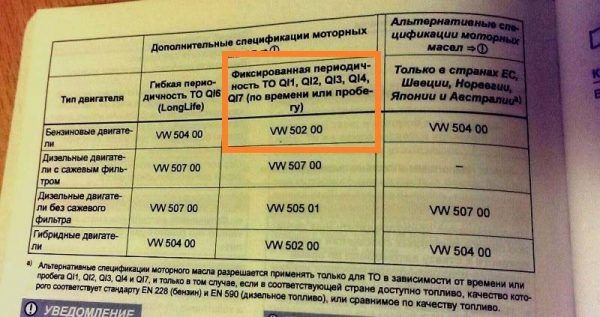
Lubricants with tolerances 504 00 and 507 00 have other disadvantages:
- lower content of detergent additives, for the sake of the environment;
- LowSAPS oil fluids are low viscosity, available in 5W-30 viscosity only.
Naturally, a decrease in useful additives leads to increased engine wear, no matter how new oils are advertised. Therefore, the best lubricating fluids for Russian operating conditions will be engine oils with a VW 502.00 approval for gasoline engines and 505.00, as well as 505.01 for imported diesel engines.
Viscosity characteristics
Viscosity parameters are among the most important. The viscosity qualities of motor oils change with temperature. All motor oils today are multigrade. According to the SAE classification, they have low temperature and high temperature viscosity coefficients. They are separated by the symbol W. In the figure you can see a table of the dependence of the operating temperature range of lubricants on their viscosity.
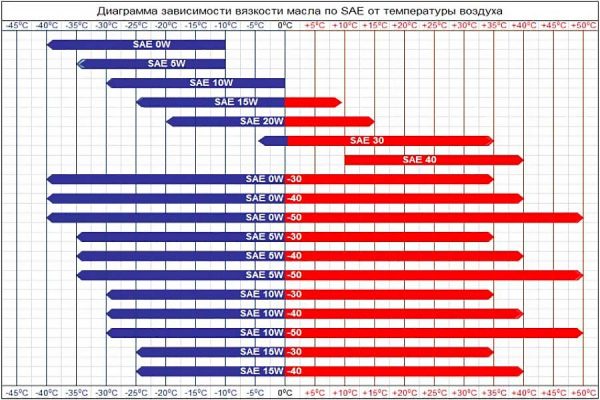
For relatively new Volkswagen Polo engines, low-viscosity 5W-30 compounds are suitable. When operating in hot southern climates, it is better to use a more viscous fluid 5W-40 or 10W-40. Residents of the northern regions, due to possible low temperatures, it is better to use 0W-30.
Regardless of the climate zone, after 100 thousand kilometers of travel, it is better for Volkswagen Polo to purchase a more viscous oil, SAE 5W-40 or 0W-40. This is due to wear, which causes an increase in the gaps between the parts of the piston block. As a result, the lubricating properties of low-viscosity fluids (W30) deteriorate somewhat, and their operating consumption increases. The automaker, the VAG concern, recommends that in the accompanying documentation for the Volkswagen Polo, adhere to 5W-30 and 5W-40 viscosities.
Cost and production technology
For Volkswagen Polo cars, synthetic lubricants should be used. Any motor lubricant consists of a base oil and a set of additives. It is the base component that determines the main characteristics. Now the most common base oils are made from oil, by deep refining (hydrocracking). These products are sold as semi-synthetic and synthetic (VHVI, HC-synthetics). In fact, this is nothing more than a marketing ploy. Such oils are much cheaper than fully synthetic base compounds (PAO, Full Synthetic) made on the basis of polyalphaolefins (PAO).
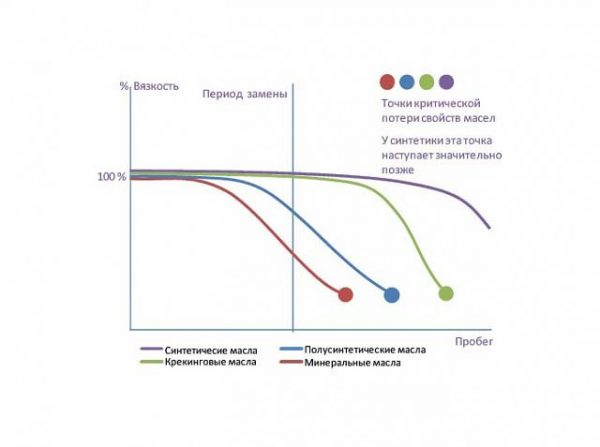
In hydrocracking, many indicators are close to synthetics, but the thermal-oxidative stability is lower. Therefore, VHVI loses its properties faster than Full Synthetic. Hydrocracking needs to be changed more often - but for Russian conditions this drawback is not critical, since the lubricant still needs to be changed faster than the recommended time. Below is the estimated cost of some lubricants that are suitable for VW Polo power units:
- The cost of the original HC-synthetic German oil VAG Longlife III 5W-30 in a 5-liter canister starts from 3500 rubles. It will just be a replacement for the Volkswagen Passat (3.6–3.8 l) and will still be left for topping up liquid during operation.
- Castrol EDGE Professional LongLife 3 5W-30 is cheaper - from 2900 rubles, but the volume of the canister is less, 4 liters.
- A fully synthetic product, Motul 8100 X-max 0W-40 ACEA A3 / B3 4 liters, is sold at a price of about 4 thousand rubles.
How to avoid buying counterfeit products
Now the Russian market is flooded with counterfeit counterfeit products. Distinguishing a fake from an original can be difficult even for professionals, not to mention motorists. Therefore, you should follow the rules, the observance of which will significantly reduce the likelihood of acquiring a fake:
- Follow the manufacturer's recommendations for tolerances and viscosity characteristics of motor fluids.
- Do not be tempted by the low price of the proposed lubricants - this is where counterfeit products are most often sold.
- Purchase oil cans only at large specialized retail outlets or from authorized dealers.
- Before buying, find out the opinion of more experienced colleagues on where it is better to buy original auto chemicals.
- Do not buy motor lubricant in the markets, from dubious sellers.
Remember - using a fake will lead to engine failure. Overhaul of the motor will cost its owner dearly.
Video: what kind of oil is better to fill in a VW Polo
Signs and effects of "aging" engine oil
There are no visual signs indicating the need to replace the lubricant. Many motorists, especially beginners, mistakenly believe that since the oil composition has darkened, it needs to be changed. In fact, this only speaks in favor of a lubricant product. If the liquid has darkened, it means that it washes the engine well, adsorbing slag deposits. But those oils that do not change their color over time should be treated with caution.
The only guideline that gives information about the replacement is the mileage since the last update of the lubricant. Despite the fact that official dealers offer a replacement after 10 or 15 thousand km, you need to do this more often, without driving more than 8 thousand. After all, Russian gasoline contains many impurities that oxidize the oil and cause the loss of its protective properties. It should also not be forgotten that in difficult urban conditions (traffic jams) the engine runs for a long time during machine downtime - that is, the lubrication resource is still reduced. The oil filter must also be changed with every oil change.
What happens if you change the oil at an extended interval
If you are not serious about the frequency of replacement, and also fill in lubricant that is not suitable for the motor, this is fraught with a decrease in engine life. Such a diagnosis does not appear immediately, therefore it is invisible. The oil filter becomes clogged and the engine begins to be washed by dirty motor fluid containing slag, sludge and small chips.
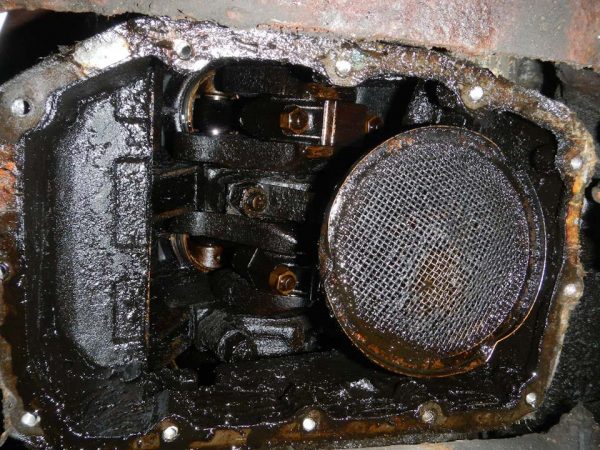

Pollution settles in oil lines and on the surfaces of parts. Engine oil pressure drops, eventually disappears altogether. If you do not pay attention to the pressure sensor, the following will follow: jamming of the pistons, cranking of the connecting rod bearings and breakage of the connecting rods, failure of the turbocharger and other damage. In this state, it is easier to buy a new power unit, since a major overhaul will no longer help him.


If the situation is not yet hopeless, active flushing can help, and then periodic replacement with high-quality fresh oil after 1–1.5 thousand km of quiet driving, at low engine speeds. The procedure for such a replacement must be performed 2-3 times. Perhaps then the overhaul will be able to delay, for a while.
Step-by-step instructions for changing engine oil
Self-replacement work should be carried out on a viewing hole, overpass or lift. It is worth preparing for the procedure in advance: purchase a 4- or 5-liter canister of engine fluid, an oil filter (original catalog number - 03C115561H) or its equivalent, a new drain plug (original - N90813202) or a copper gasket to it. In addition, prepare the tool and aids:
- an empty container for draining used grease, with a volume of 5 liters;
- key for removing the oil filter;
- ring wrench 18 - to remove the drain plug;
- a T25 Torx bit, a 13 head and a ratchet - to remove the crankcase protection;
- funnel for filling oil and rags.
After everything is prepared, you can proceed:
- The engine is warmed up by a short trip, after which the car is placed over the inspection hole.
- The hood opens and the oil filler plug is unscrewed.
- The oil filter is unscrewed half a turn. The valve located under the filter opens slightly and the oil flows out of it into the crankcase.

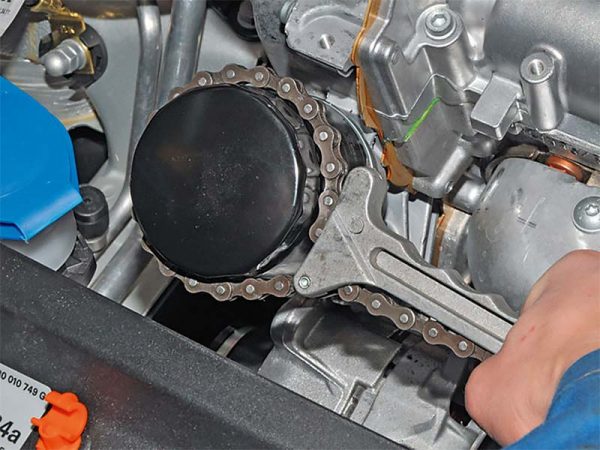 The filter should be moved only half a turn counterclockwise so that oil flows out of it.
The filter should be moved only half a turn counterclockwise so that oil flows out of it. - Using a tool, the crankcase protection is removed.
- With a key of 18, the drain plug moves from its place.

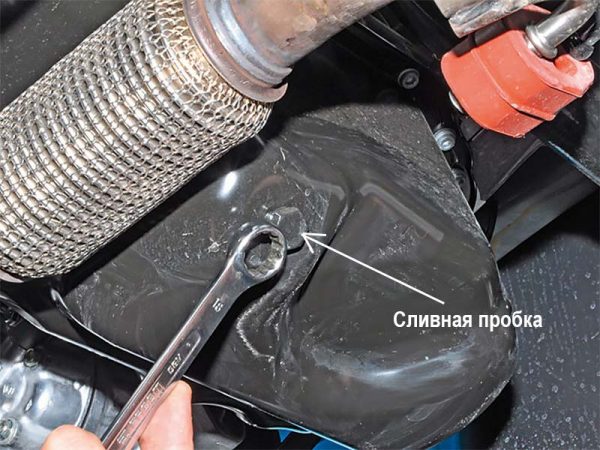 To unscrew the cork, it is better to use the key in the form of an "asterisk"
To unscrew the cork, it is better to use the key in the form of an "asterisk" - An empty container is substituted. The cork is carefully unscrewed with two fingers so as not to burn yourself with hot liquid.
- Used grease is drained into a container. You should wait about half an hour until liquid stops dripping from the hole.
- The drain plug with a new gasket is screwed into its seat.
- Removed the old oil filter. The sealing ring of the new filter is lubricated with engine oil.

 Before installation, fresh oil should not be poured into the filter, otherwise it will leak onto the motor
Before installation, fresh oil should not be poured into the filter, otherwise it will leak onto the motor - The fresh filter is screwed into place.

 The filter must be twisted by hand until a strong resistance is felt.
The filter must be twisted by hand until a strong resistance is felt. - Through the oil filler plug, about 3.6 liters of new engine fluid is carefully poured into the engine. The oil level is periodically checked with a dipstick.
- As soon as the liquid level approaches the maximum mark on the dipstick, filling stops. The fill plug is screwed into place.
- The engine turns on and runs for 2-3 minutes in neutral gear. Then you need to wait 5-6 minutes until the oil collects in the crankcase.
- If necessary, the oil is added until its level reaches the middle between the dipstick marks MIN and MAX.
Video: changing engine oil in a Volkswagen Polo


Watch this video on YouTube
By following the above recommendations and regularly changing the lubricant in the motor, you can achieve long and trouble-free operation. In this case, the engine is able to travel 150 thousand km or more without major repairs. Therefore, the increase in costs associated with a shortened interval between replacements will soon pay off in the long run.

